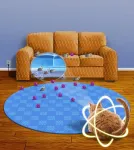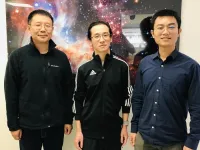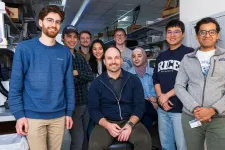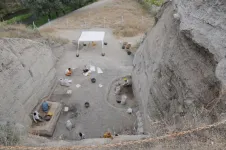(Press-News.org) Sunday, April 14, 2024 - Toronto - “Dreams are messages from the deep.” (Dune Part 1) Musings about dreams abound throughout society, from movies to TV to books. But despite being a constant source of fascination, the role of dreams in our lives still remains elusive. As recently noted in the TV show Grey’s Anatomy: “Honestly, no one knows why we dream or why we have nightmares.” While true, neuroscientists are finding innovative new ways to study dreams and how they influence our cognition.
“Understanding how dreams are generated and what their function might be — if any — is one of science's biggest open questions right now,” says Remington Mallett of University of Montréal, who is chairing a session today at the annual meeting of the Cognitive Neuroscience Society (CNS) in Toronto. “Because we don't know much about dreams, it is hard to estimate their full impact on our waking lives. But current results suggest that indeed dreams influence our waking experiences.”
As presented at CNS 2024, researchers are finding not only novel approaches to exploring dreams and the architecture of sleep, but also ways to engineer dreams to help people suffering from sleep disorders. In the process, scientists are seeing how perceptions of dreams and sleep quality often differ greatly from the objective measures traditionally used to evaluate them.
Perceptions versus reality
Claudia Picard-Deland posits that dreams are a window into understanding sleep quality. She and colleagues at the University of Montréal design studies that wake sleepers many times in the night to determine how the participants perceive their sleep.
“Dreams are not studied a lot in the context of sleep quality. The focus is more often on objective measures like brain activity or sleep stage, but I think we need to look closer at dream activity and its impact on how we perceive sleep.” For people who suffer from insomnia and related disorders, perception of sleep is reality, and their dreams could offer possible ways to help shape those perceptions.
In their latest, unpublished study, Picard-Deland and colleagues woke 20 “good sleepers” some 12 times in the night, representing all four classic sleep stages at three different times in the night. At each awakening, the researchers would ask whether they had been awake or asleep, how deeply they were sleeping, what was last in their minds, and how immersed they felt in their dreams.
They found that sleep misperception — feeling awake even when electrodes measured they were asleep — was common among participants, especially in the early, dreamless stages of sleep. Likewise, they found that when the participants were able to recall their dreams, they perceived their sleep as deeper. “And when they are more immersed in their dreams, feel more physically present, or have more vivid dreams, they wake up feeling their sleep was deeper compared to when they have no, or light, dream activity,” Picard-Deland says.
The researchers were surprised to see how frequently participants thought they had been awake when they were actually sleeping (“paradoxical insomnia”) and in the deeper, slow-wave phase of sleep. This work builds upon similar previous findings and has important implications for how scientists understand the architecture of sleep, as well as for people who report insomnia.
As someone who has experienced insomnia her whole life, Picard-Deland thinks it is crucial for people to realize that they may be sleeping more than they think. “It helped me to see it with my own eyes, happening in front of me, that participants were sleeping yet still felt awake.” Beyond that understanding, this work could have future applications for sleep rehabilitation based on dreams. For example, Picard-Deland would love to explore whether dream training, such as teaching people how to experience more immersive lucid dreams, could lead to better perceived sleep quality.
Lucid dreams as a tool
Lucid dreams are an important part of the work of Saba Al-Youssef whose team at Sorbonne Université leverages the ability of lucid dreamers to use facial muscles during sleep as a new tool for gathering data. “Dreams are a hidden world to which we have no direct access,” she says. “We mostly rely on dream reports no matter what study method we use. The capacity of lucid dreamers to communicate with us in real time gives us side door access to dreams, at least knowing when a specific event is happening.”
In a new study with researchers at Northwestern University, Al-Youssef and colleagues aim to better understand how the brain acts during dreams in comparison to its behavior when awake. When people are awake and close their eyes, visual content disappears and specific electrical signals occur. Researchers therefore wondered what happens in the brain when someone closes their eyes in a dream. They hope to better understand the neural correlates of visual perception during dreams.
The researchers recruited participants who included lucid dreamers with narcolepsy. Over the course of five naps, the researchers instructed participants to close and open their “dream eyes” and signal so by sniffing once or twice. They then asked those with narcolepsy to report whether they had visual content in each condition by frowning or smiling.
“Surprisingly, we've found that closing our ‘dream eyes’ is not always accompanied by a loss of vision, as is the case when we're awake,” Al-Youssef says. “I hope this work would help show how using lucid dreams can be helpful in studying dreams and even understanding their function.”
Mallett is excited to see work like this to develop new methodology for studying dreams. “I think most scientists are skeptical that dreams can be studied, so before I tell them about what we found, I need to convince them that we can find something,” Mallett says, “that we have the methods and tools to make discoveries about dreams.”
Both Picard-Deland’s and Al-Youssef’s work open new avenues of research in manipulating dreams through new technology and with immediate clinical benefits. “You need to manipulate dreams for good experimentation, and you need to manipulate dreams to reduce nightmares,” he says. “Nightmares are incredibly frustrating for a variety of clinical populations, and there is great need for approaches to reducing them. Understanding how dreams are formed, and how to change them, is already laying paths forward for efficient nightmare reduction protocols.”
Overall, the body of work presented at CNS 2024 is showing the myriad ways dreams affect our waking lives. “This is rather unsurprising when you consider that dreams are experiences, and your prior experience is always going to impact your experiences going forward.” The work also echoes a fundamental lesson from cognitive neuroscience, that whether awake or asleep, our perceptions of the world are but imperfect creations in our minds.
–
The symposium “Into the Night: The Cognitive Neuroscience of Dreaming” is taking place at 1:30pmEDT on Sunday, April 14, as part of the CNS 2024 annual meeting from April 13-16, 2024 in Toronto, Canada.
CNS is committed to the development of mind and brain research aimed at investigating the psychological, computational, and neuroscientific bases of cognition. Since its founding in 1994, the Society has been dedicated to bringing its 2,000 members worldwide the latest research to facilitate public, professional, and scientific discourse.
END
Untangling dreams and our waking lives
CNS 2024
2024-04-14
ELSE PRESS RELEASES FROM THIS DATE:
Important health information missing in online food delivery menus
2024-04-14
A University of Sydney study investigating menu items on major online food delivery outlets and applications (apps) in Australia has found most advertised items are missing nutritional information that would otherwise help consumers make healthy choices.
Researchers say the findings show this information is largely absent or poorly provided on online food retail platforms and menu labelling laws need to keep up with increasing demand of online food delivery services.
The 2011 New South Wales Menu Labelling Scheme require large fast-food outlets to display both the average energy content (as Kilojoules) on menu items and the reference statement ‘the ...
UK/Portuguese study strongly suggests antibiotic-resistant “superbugs” are being passed from cats and dogs to their owners
2024-04-13
Finding highlights the importance of including pet-owning households in surveillance programmes for antibiotic resistance
**Note: the release below is a special early release from the ESCMID Global Congress (formerly ECCMID, Barcelona, Spain, 27-30 April). Please credit the congress if you use this story**
**ECCMID has now changed name to ESCMID Global, please credit ESCMID Global Congress in all future stories**
Pet dogs and cats play an important role in the spread of antibiotic-resistant bacteria, new research be presented at the ESCMID Global ...
Researchers study effects of solvation and ion valency on metallopolymers
2024-04-12
In a new paper published in JACS AU, researchers at the University of Illinois Urbana-Champaign analyzed the effects of solvation and ion valency on metallopolymers, with implications for critical materials recovery and recycling, and environmental remediation.
Chemical and biomolecular engineering (ChBE) professor Xiao Su led the research, which explored the science behind the selectivity “preferences” of monovalent and divalent anions towards redox polymers. In other words, why – when electrodes are coated with redox polymer films and potential is applied – one ion prefers the redox polymer while ...
Physicists solve puzzle about ancient galaxy found by Webb telescope
2024-04-12
RIVERSIDE, Calif. -- Last September, the James Webb Space Telescope, or JWST, discovered JWST-ER1g, a massive ancient galaxy that formed when the universe was just a quarter of its current age. Surprisingly, an Einstein ring is associated with this galaxy. That’s because JWST-ER1g acts as a lens and bends light from a distant source, which then appears as a ring — a phenomenon called strong gravitational lensing, predicted in Einstein’s theory of general relativity.
The total mass enclosed within the ring has two components: stellar and dark matter components.
“If ...
Clear guidelines needed for synthetic data to ensure transparency, accountability and fairness study says
2024-04-12
Clear guidelines should be established for the generation and processing of synthetic data to ensure transparency, accountability and fairness, a new study says.
Synthetic data - generated through machine learning algorithms from original real-world data - is gaining prominence because it may provide privacy-preserving alternatives to traditional data sources. It can be particularly useful in situations where the actual data is too sensitive to share, too scarce, or of too low quality.
Synthetic data differs from real-world data as it is generated by algorithmic models known as synthetic data generators, such as Generative Adversarial ...
Report finds significant gender and racial inequities in the educational measurement profession
2024-04-12
Washington, April 12, 2024—Gender and racially based employment disparities, differences in perceptions of diversity, equity, and inclusion (DEI), and workplace discrimination remain significant issues in the field of educational measurement, according to a new report supported by the American Educational Research Association (AERA), the National Council on Measurement in Education (NCME), and Women in Measurement (WIM). Educational measurement professionals who work at universities, thinktanks, and other research organizations are ...
University of Houston and Scotland’s Heriot-Watt University forge strategic energy alliance
2024-04-12
HOUSTON, April 10, 2024 - The University of Houston (UH) and Scotland’s Heriot-Watt University (HWU) signed a memorandum of understanding (MOU) today, marking the beginning of their partnership to foster global collaboration in education, research and innovation in the energy sector and beyond.
At the heart of the MoU lies a commitment to advance research that helps society deliver a just energy transition, with a particular emphasis on hydrogen – a critical element in the transition to sustainable energy ...
Rice team demonstrates miniature brain stimulator in humans
2024-04-12
HOUSTON – (April 12, 2024) – Rice University engineers have developed the smallest implantable brain stimulator demonstrated in a human patient. Thanks to pioneering magnetoelectric power transfer technology, the pea-sized device developed in the Rice lab of Jacob Robinson in collaboration with Motif Neurotech and clinicians Dr. Sameer Sheth and Dr. Sunil Sheth can be powered wirelessly via an external transmitter and used to stimulate the brain through the dura ⎯ the protective ...
Jennifer Stinson receives prestigious Barer-Flood Prize in health services research
2024-04-12
Jennifer Stinson a renowned researcher in the field of chronic pain management in children, has received the 2023 Barer-Flood Prize from the Canadian Institutes of Health Research (CIHR).
The prize, named in honour of the first two Scientific Directors of CIHR-IHSPR, Drs. Morris Barer and Colleen Flood, recognizes the highest-ranking senior-career investigator who identifies as a woman, and their research excellence.
Dr. Stinson, a Professor at the Lawrence Bloomberg Faculty of Nursing, Institute of Health Policy, Management and Evaluation, and Temerty Department of Anesthesiology & Pain Medicine, is being acknowledged ...
First insights into the genetic bottleneck characterizing early sheep husbandry in the Neolithic period
2024-04-12
Modern Eurasian sheep predominantly belong to only two so-called genetic matrilineages inherited through the ewes. Previous research thereby assumed that genetic diversity must already have decreased rapidly in the early stages of domestication of wild sheep. Our study of a series of complete mitogenomes from the early domestication site Asıklı Höyük in central Anatolia, which was inhabited between 10,300 and 9,300 years ago, disproves this assumption: despite a millennium of human interference with the keeping and breeding of sheep, mitogenomic diversity remained invariably high, with five matrilineages ...
LAST 30 PRESS RELEASES:
University of Oklahoma researcher awarded funding to pursue AI-powered material design
Exploring how the visual system recovers following injury
Support for parents with infants at pediatric check-ups leads to better reading and math skills in elementary school
Kids’ behavioral health is a growing share of family health costs
Day & night: Cancer disrupts the brain’s natural rhythm
COVID-19 vaccination significantly reduces risk to pregnant women and baby
The role of vaccination in maternal and perinatal outcomes associated with COVID-19 in pregnancy
Mayo Clinic smartwatch system helps parents shorten and defuse children's severe tantrums early
Behavioral health spending spikes to 40% of all children’s health expenditures, nearly doubling in a decade
Digital cognitive behavioral treatment for generalized anxiety disorder
Expenditures for pediatric behavioral health care over time and estimated family financial burden
Air conditioning in nursing homes and mortality during extreme heat
The Alps to lose a record number of glaciers in the next decade
What makes a good proton conductor?
New science reporting guide published for journalists in Bulgaria
New international study reveals major survival gaps among children with cancer
New science reporting guide published for journalists in Turkey
Scientists develop a smarter mRNA therapy that knows which cells to target
Neuroanatomy-informed brain–machine hybrid intelligence for robust acoustic target detection
Eight SwRI hydrogen projects funded by ENERGYWERX
The Lundquist Institute and its start-up company Vitalex Biosciences Announces Strategic Advancement of Second-Generation fungal Vaccine VXV-01 through Phase 1 Trials under $40 Million Competitive Con
Fine particles in pollution are associated with early signs of autoimmune disease
Review article | Towards a Global Ground-Based Earth Observatory (GGBEO): Leveraging existing systems and networks
Penn and UMich create world’s smallest programmable, autonomous robots
Cleveland researchers launch first major study to address ‘hidden performance killer’ in athletes
To connect across politics, try saying what you oppose
Modulating key interaction prevents virus from entering cells
Project explores barriers to NHS career progression facing international medical graduates
Jeonbuk National University researchers explore the impact of different seasonings on the flavor perception of Doenjang soup
Two Keck Medicine of USC Hospitals named Leapfrog Top Teaching Hospitals
[Press-News.org] Untangling dreams and our waking livesCNS 2024





